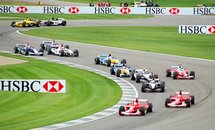Formula One racing
|
|
 Formula One cars wind through the infield section of the Indianapolis Motor Speedway during the 2003 United States Grand Prix | ||
|
- This article focuses on a specific subtopic of Formula One.
A Formula One race takes place over an entire weekend, with free practice on Friday, two practice sessions and a qualifying session on Saturday, and the race on Sunday.
Free Practice Sessions
The event usually begins on Friday (except in Monaco where it begins on Thursday) with two free practice sessions, from 11:00 to 12:00 and from 14:00 to 15:00, for the drivers to learn the circuit and for the teams to experiment with their cars to figure out the best settings for the particular track. Further free practice sessions will take place on Saturday from 9:00 to 9:45 and from 10:15 to 11:00; during events in North America the Saturday free practice sessions will take place from 8:00 to 8:45 and from 9:15 to 10:00.
Qualifying Sessions
On Saturday at 13:00 (except in North America where the starting time is at 12:00) the qualifying session takes place, using the format of allowing each driver to set one "flying lap" time on an empty track. The order of running in the qualifying session is determined by the results of the last race, with the victor of the last race running last in the qualifying session. A driver or car that sets the fastest time qualifies at the front of the grid and is said to be in pole position. There are typically races in other FIA series (such as Formula 3000) over the weekend to keep crowds entertained.
Historically there were often an excess of cars that wished to compete in F1, so teams had to pre-qualify for the opportunity to race and "DNQ" (Did Not Qualify) was a common designation if the qualifying time of the car was not within 110% of the pole sitters time. There are now only 10 teams in Formula 1 so the 110% rule has been removed since the FIA's rules indicate that 24 cars can take the start of an F1 race, the minimum is 20 cars. Each team has 2 cars, and if a team was to drop out the remaining teams would have to figure out how to maintain the 20 car rule. The current Concorde agreement expires at the end of the 2007 season.
Race
Start_lights.jpg
See Formula One regulations for detailed information on the race start procedure.
The race itself, held on the Sunday afternoon, begins with a warm-up lap, after which the cars are assembled on the starting grid in the order they qualified. They then go on the signal of the starting light system, which consists of five lights mounted above the start/finish line which light up at one second intervals. After a random length of time (no more than a few seconds) the red lights all go dark, at which point the race starts. Races are a little over 300 kilometres (180 miles) long, though occasionally some races are truncated due to special circumstances. However, no race will go on for longer than two hours.
Drivers usually stop for fuel at least once, and possibly two or three times. The cars, on average, get 4 miles per galon. As of the 2005 season tyre changes during the race are no longer allowed. Tyres may be changed only if deemed dangerous to the driver or other cars. The FIA must examine changed tyres after the change to make the official call. If deemed still appropriate the car and driver will get a positional penalty.Timing pitstops with reference to other cars is crucial - if following another car but unable to pass, drivers will pit early in the expectation that when they rejoin the race they will land in clear track where they will be able to drive as fast as they can go, and thus make up overall time and pass the other car "in the pits".
At the finish of the race, the first-, second-, and third-placed drivers take their places on a podium, where they stand as the national anthem of the race winner's home country and that of his team is played. Dignitaries from the country hosting the race then present trophies to the drivers and a constructor's trophy to a representative from the winner's team, and the winning drivers spray each other and the fans with champagne. The three drivers then go to a media room where they answer questions in English and their native languages.
Points are awarded to drivers and teams exclusively on where they finish in a race, with the winner receiving 10 points, the second place finisher 8 points, third 6, fourth 5, fifth 4 and sixth 3, seventh 2 and eighth 1. The winner of the annual championship is the driver (or team, for the constructor's championship) with the most points.
Despite being the pinnacle of racing in terms of budgets, and driver skill, Formula One racing has often been accused of being unexciting when compared to less-prestigious categories. The differences in driver ability are usually dwarfed when compared to the relative speed of the different makes of cars, and on-track overtaking is very rare due to the aerodynamics of trailing cars being adversely affected by the car in front (making overtaking only possible by very risky and thus rarely-taken chances, or a much faster car trailing a slower one).
The sport is lesser-known in the United States than either their mostly-domestic open-wheeler racing series (at the moment there are two major ones, IRL and Champcars) or NASCAR, but in terms of budgets and global TV audiences F1 is bigger than all three. Estimates for Ferrari's racing budget in 1999 were around 240 million USD, and even tailender Minardi reportedly spent 50 million. Estimates of TV audiences are around 300 million per race.
